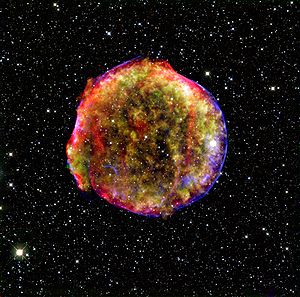2nd Week: Properties of Astrophysical Plasmas: Difference between revisions
| Line 46: | Line 46: | ||
==Thermodynamical variables and potentials== | ==Thermodynamical variables and potentials== | ||
Internal Energy | |||
<math>U = TS - PV + \sum_i \mu_i N_i</math> | <math>U = TS - PV + \sum_i \mu_i N_i</math> | ||
Helmholtz free energy | |||
<math>F = U-TS</math> | <math>F = U-TS</math> | ||
Enthalpy | |||
<math>H = U+PV</math> | <math>H = U+PV</math> | ||
Gibbs free energy | |||
<math>G = U+PV -TS</math> | <math>G = U+PV -TS</math> | ||
Landau Potential (Grand potential) | |||
<math>\Omega = U-TS-\sum_i \mu_i N_i</math> | <math>\Omega = U-TS-\sum_i \mu_i N_i</math> | ||
==Equation of state== | ==Equation of state== | ||
Revision as of 13:54, 27 January 2009
Plasma is a state of matter in which the atoms and the molecules are so hot, that they have ionized into negatively charged electrons and positively charged ions. The plasma found in the universe, whose physical properties are studied in astrophysics is known as astrophysical plasma. To study the properties of astrophysical plasma the equation of state of matter is very important. Here, we will bring some basic tools from thermodynamics and derive the equation of state for non-relativistic and relativistic plasma.
Basic thermodynamics for quantum systems
The particle density is determined as follows
where is the occupation probability and is the state density per unit volume.
The energy density is given by
where in the energy of the particle.
The pressure is defined as
where is the value of the momentum of the particle and is its velocity.
Distribution functions
In statistical physics the density of states of a system describes the number of states at each energy level that are available to be occupied. The general form of the density of state is as follows:
where is the number of states.
For the non-relativistic system
where is the statistical weight. Then the density of state is
There are four probability distribution functions in statistical physics that are known with infinite support: Gibbs distribution, Maxwell-Boltzmann distribution, Fermi-Dirac distribution and Bose-Einstein distribution. Herein we provide the expressions for the last three of them.
Thermodynamical variables and potentials
Internal Energy
Helmholtz free energy
Enthalpy
Gibbs free energy
Landau Potential (Grand potential)


















